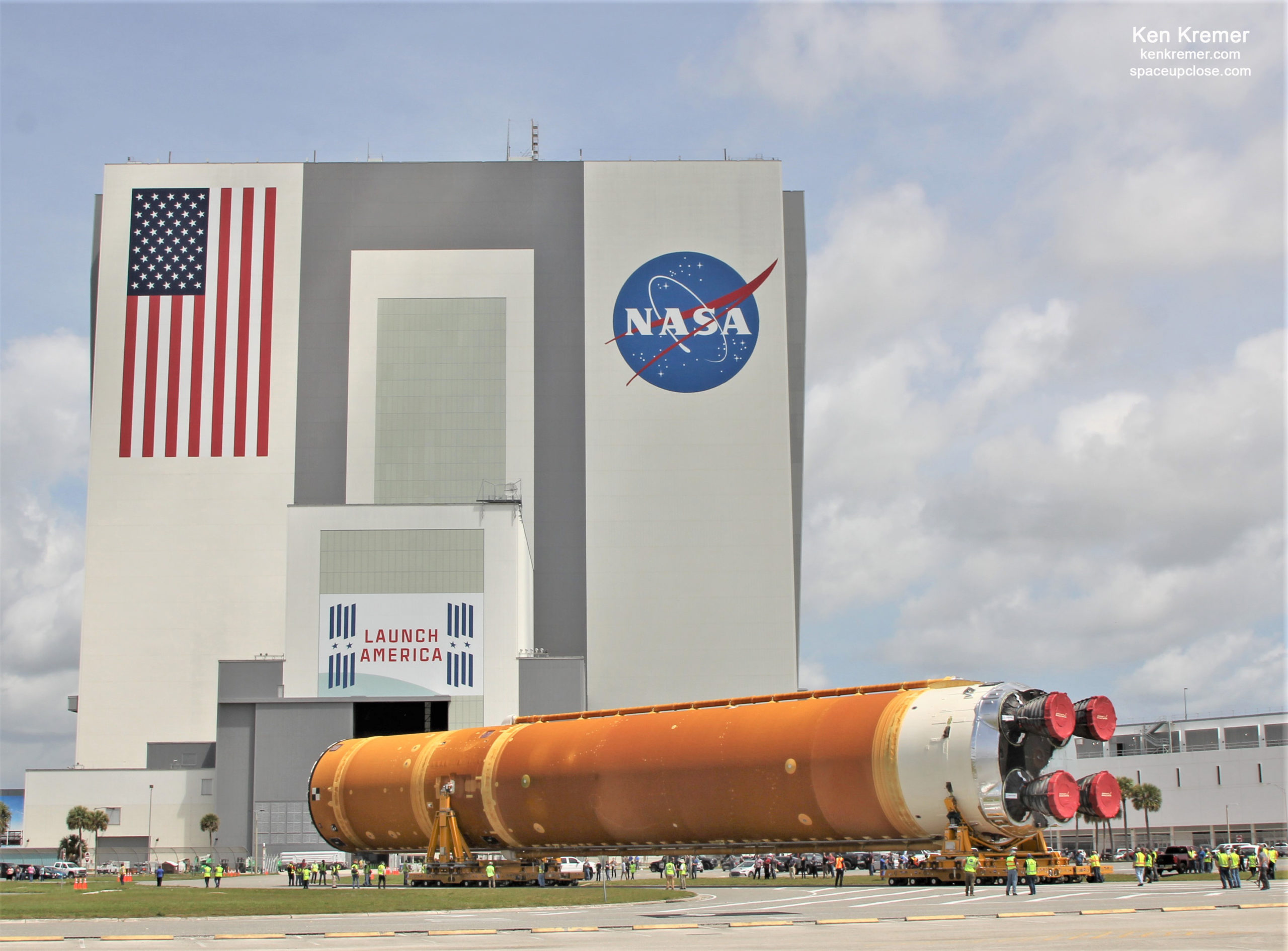
For SpaceUpClose.com & RocketSTEM
KENNEDY SPACE CENTER, FL – The first ever built and truly mammoth core stage for NASA’s Space Launch System (SLS) mega rocket arrived at NASA’s Kennedy Space Center (KSC) in Florida by barge late Tuesday afternoon April, 27, and was then rolled off the barge and into the iconic Vehicle Assembly Building (VAB) Thursday morning April 29 where it will soon begin extensive stacking and preparatory operations for launch on the history making Artemis 1 mission to deliver NASA’s Orion deep space human rated capsule to the Moon.
Liftoff of Artemis 1 is slated for no earlier than (NET) late 2021 from Launch Complex 39B at NASA KSC on the first in a series of increasingly complex missions to test the SLS heavy lift mega rocket and Orion crew capsule as an integrated system prior to crewed flights to the Moon.

“We are thrilled to welcome the Core Stage to Florida for our team to begin the integration of the SLS launch vehicle” said Mike Bolger, NASA’s Exploration Ground Systems program manager at Kennedy Space Center in Florida.
“We have been working diligently towards this moment and are honored to contribute to our nation’s space exploration goals with the launch of Artemis I.”
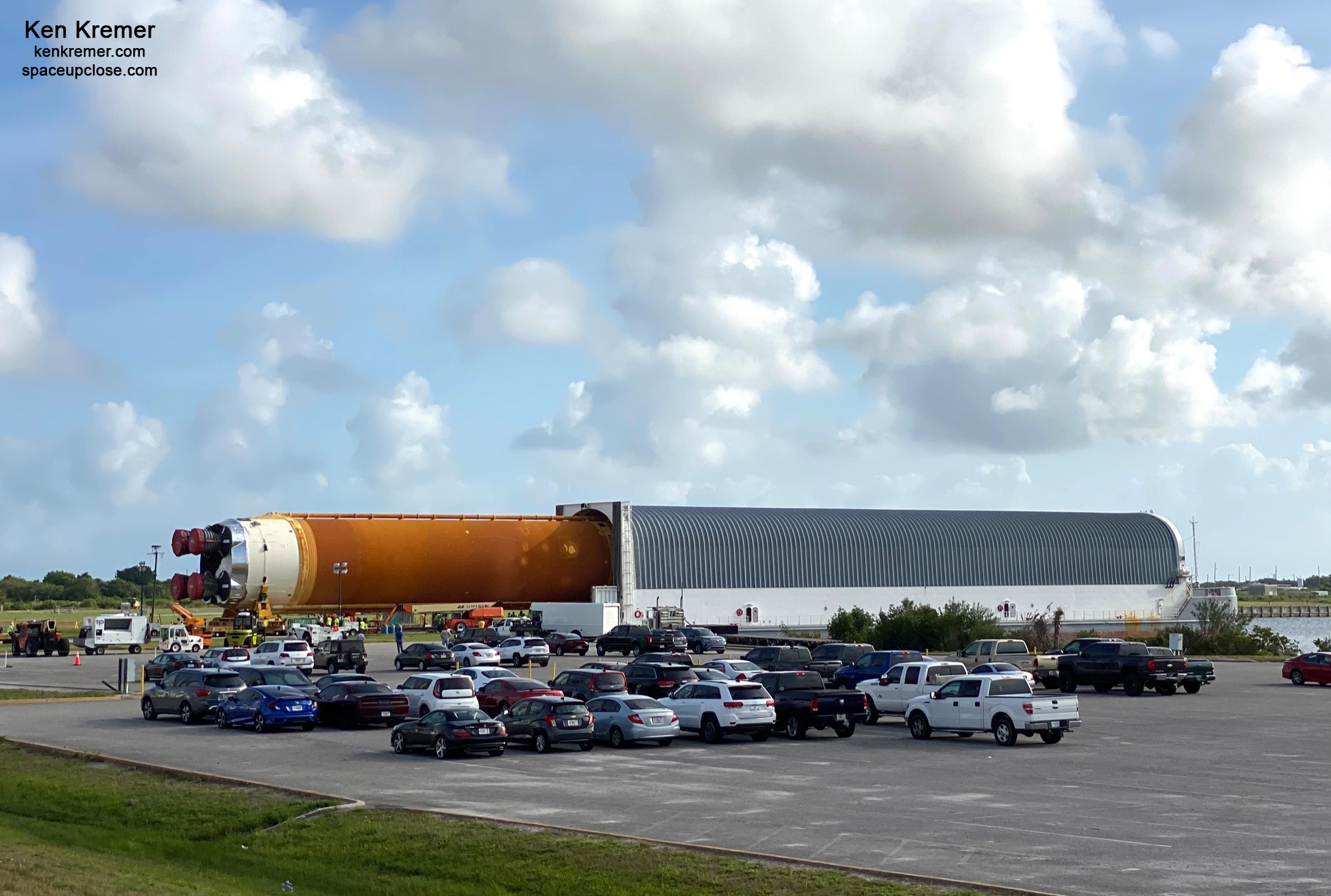
SLS is the most powerful rocket the world has ever seen generating some 8.8 million pounds of liftoff thrust at ignition – about 15% more powerful than NASA’s legendary Saturn V that hurled the first humans to land on the Moon back in 1969 on the Apollo 11 moon landing mission.
The 21-story tall core stage covered in orange foam insulation also counts as the largest and most powerful rocket stage NASA has ever built.

The SLS core stage is the final piece of NASA’s Space Launch System (SLS) rocket to arrive at KSC – and will propel NASA’s Artemis I mission to the Moon on a launch still targeted by NASA for late 2021 but that could slip into early 2022 considering the huge amount of processing and preparation work still ahead.

The decade in the making Boeing built Artemis 1 core stage safely arrived by barge at KSC in Florida after a 900-mile journey from the agency’s Stennis Space Center near Bay St. Louis, Mississippi

The maiden 212-foot-tall (64.6-meter) SLS core stage arrived aboard the specially designed and elongated 310-foot-long (94.4 meters) Pegasus barge and was towed into the Launch Complex 39 turn basin wharf on a sunny Tuesday afternoon berthing adjacent to the iconic VAB and passing by the proudly fluttering US Flag and world famous Countdown Clock.

Finally just past dawn teams of technicians with NASA’s Exploration Ground Systems (EGS) and lead contractor Jacobs slowly and methodically began the off load operation of the core stage from Pegasus at about 8:30 a.m. EDT (1230 GMT) Thursday, April 29.
The core stage resting on a transport cradle was offloaded from Pegasus using a self-propelled module transporter to move it into the iconic Vehicle Assembly Building.
The start of the offloading operation was delayed over 2 hours due to a fuse issue with the self-propelled transporter.
Enjoy our photos of the core stage off loading and barge arrival at Port Canaveral and KSC Turn Basin wharf from the Space UpClose team of Ken Kremer and Jean Wright. Check back as the gallery grows.

The core stage finally was transported inside to the VAB transfer aisle late afternoon Thursday, April 29.

The next steps are to carefully raise the core stage vertical by cranes in about one month by late May and hoist it into High Bay 4 for stacking and attachment to the twin solid rocket boosters and the Orion capsule – those operations will take up most of the summer.
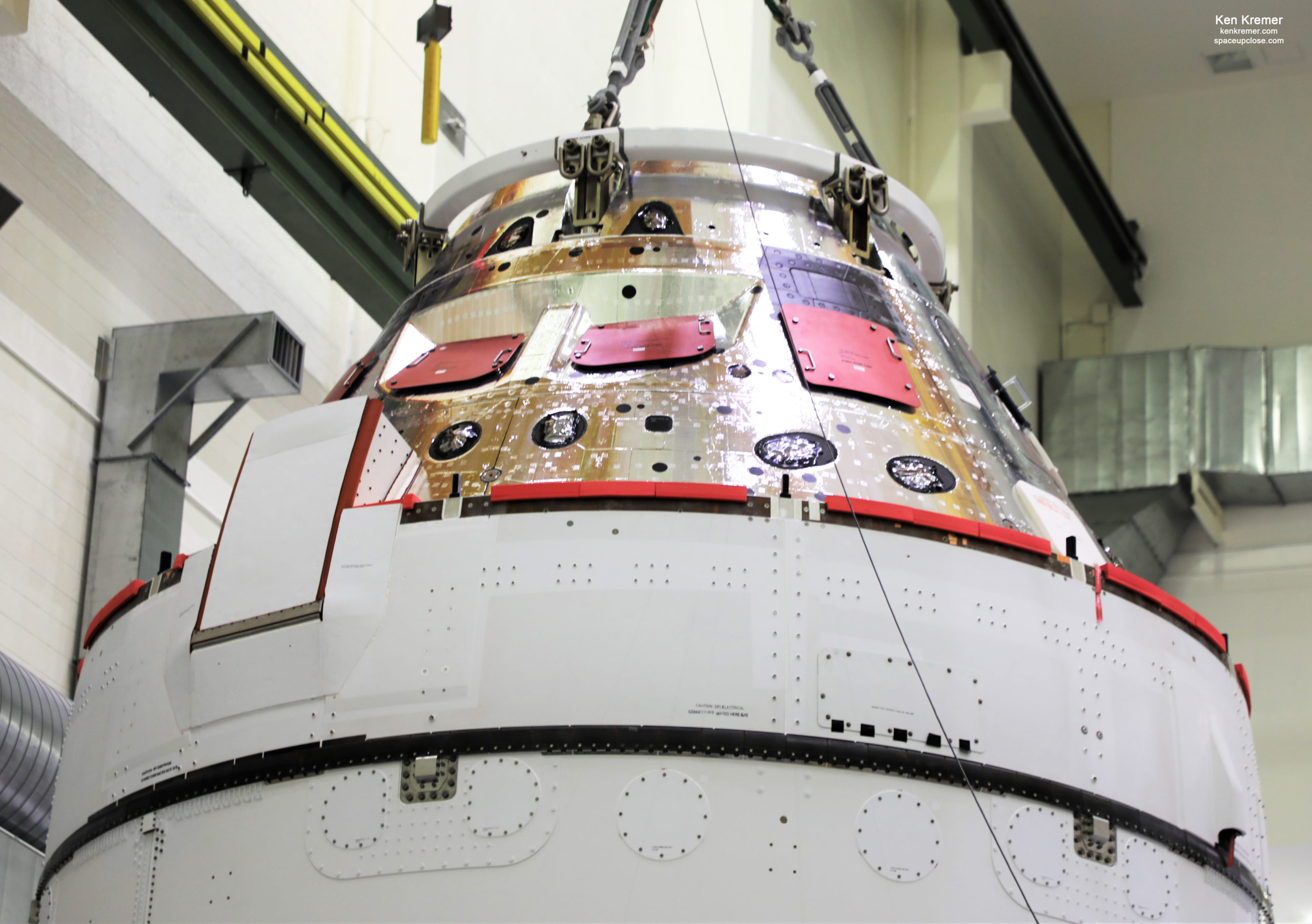
Both of the 177-foot-tall (54-meter) Northrop Grumman built solid rocket boosters (SRBs) are already stacked on the rocket’s mobile launch platform in High Bay 4 in the VAB and are awaiting the core stage.
The high bay crane will hoist and lower the core stage to place it in between the already stacked SRBs
See the NASA graphic below explain the SLS/Orion integration and stacking operation in the VAB in detail.
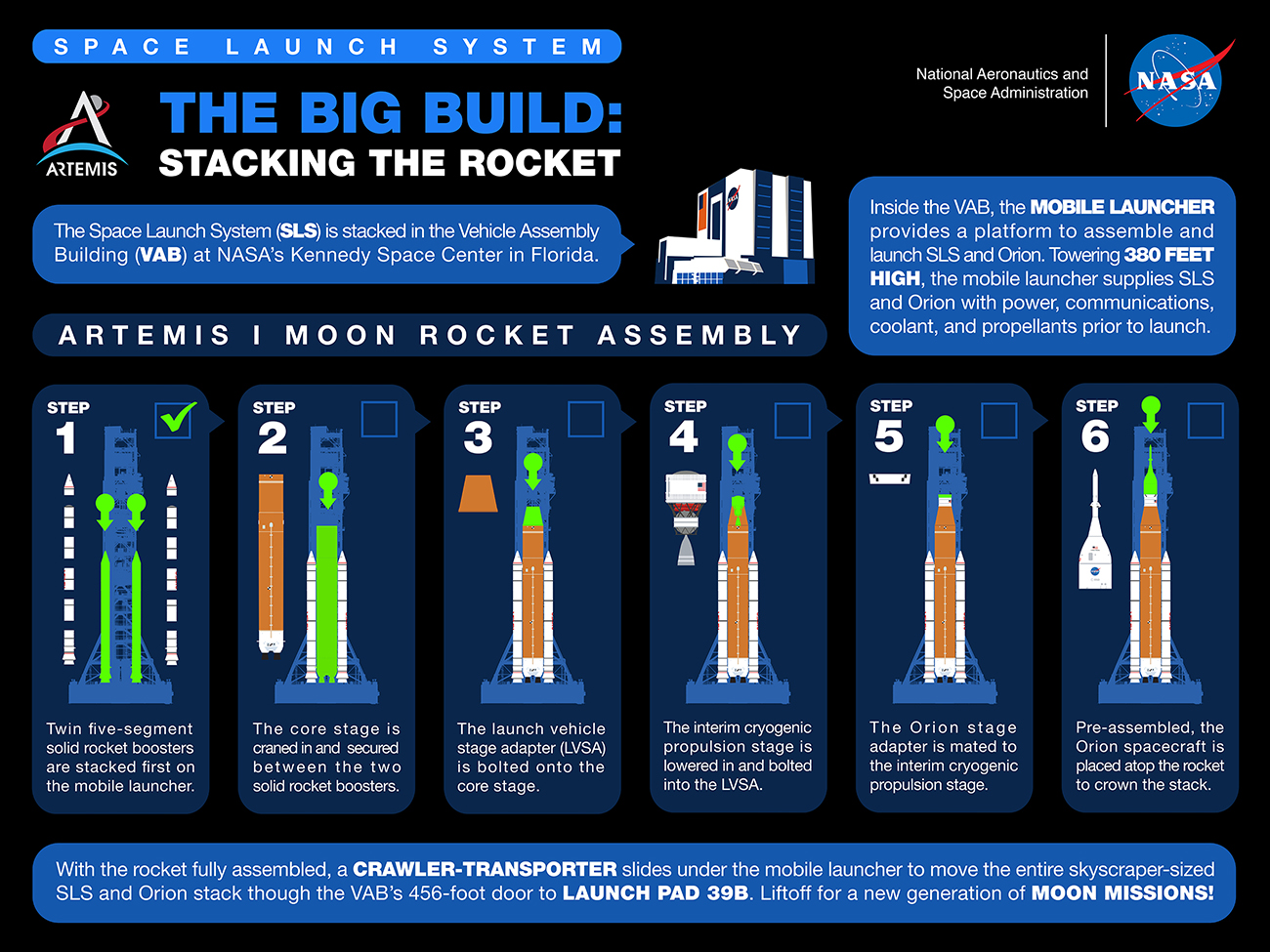
NASA’s unique Pegasus barge was previously used to transport the External Tanks (ET) for NASA’s three-decade long space shuttle program until the orbiters retirement in 2011.
“Teams from Exploration Ground Systems and contractor Jacobs will lead the efforts to integrate the massive rocket stage with the Orion spacecraft and the additional flight hardware ahead of the Artemis I launch. Waiting to greet the core stage inside the facility are the twin solid rocket boosters that have been fully stacked atop the mobile launcher and the launch vehicle stage adapter housed inside High Bay 4,” said NASA officials.
SLS serves as the backbone of the Artemis program and the nation’s future deep space exploration missions.
The SLS core stage measures 212 feet tall and 27.6 feet in diameter.
Overall SLS stands 322 feet (98 meters) tall and weighs 5.75 million pounds
It is equipped with four Aerojet-Rocketdyne built RS-25 engines fueled by over 730,000 gallons of cryogenic super cold LOX (liquid oxygen) and LH2 (liquid hydrogen) propellants to generate some 2 million pounds of liftoff thrust to help power the SLS rocket at launch.

SLS was built by prime contractor Boeing at NASA’s Michoud Assembly Facility in New Orleans.”
The RS-25 engines are attached to the base of the core stage and are recycled from the Space Shuttle where they were reused and reflown numerous times.
Previously known as the Space Shuttle Main Engine, or SSME, they have been refurbished and upgraded in numerous ways including with a new ‘brain controller’ and can fire at 109% thrust.

This 1st SLS core stage was transported to KSC following the successful completion of the critical and long awaited Green run hot test fire of the four Aerojet-Rocketdyne RS-25 engines mounted on the base of the stage.
The core stage hot fire was the culmination of the Green Run series of tests of its design and systems on the B-2 test stand in Mississippi.
NASA successfully and finally completed the full duration 8 minute long hot test fire of the core stage engines on the second try for the agency’s Space Launch System (SLS) human rated mega Moon rocket, March 18, on the test stand in Mississippi thus enabling its shipment to KSC.
After SLS/Orion stacking and integration are complete NASA hopes to roll out and transport the skyscraper-sized vehicle duo on the mobile launcher carried by the upgraded crawler-transporter for the very first time to Launch Complex-39B in the August to fall time frame for a wet dress rehearsal by the launch team.
Thereafter the fully assembled stack will roll back to the VAB for refurbishment.
Thereafter NASA officials will be able to forecast and determine a realistic launch date.
The arrival at KSC is paving the path for launch of the uncrewed Artemis-1 moon mission late this year or early next year followed by future Artemis missions with astronauts to orbit and land on the surface.

Artemis I will be the first integrated test of SLS and Orion and will pave the way for landing the first woman and first person of color on the lunar surface.

Ken is onsite for the Pegasus arrival and offloading activities at KSC
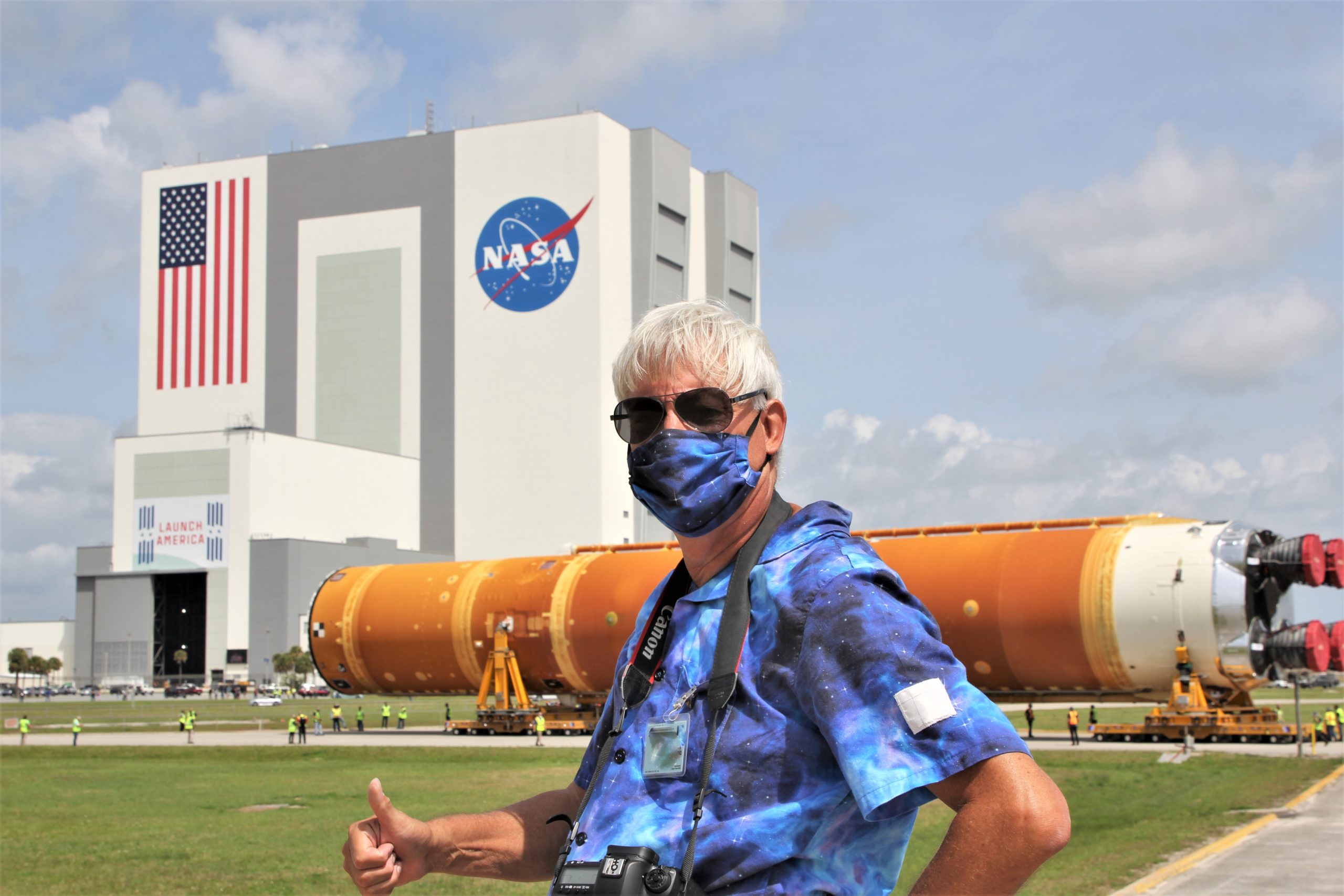
Watch for continuing detailed reports upcoming.
Watch my live SpaceX Crew-2 post launch interview on ‘The Donlan Report’ on News Nation Cable News about Artemis and the significance of the NASA SpaceX Crew 2 launch to ISS launch, Commercial Space, Mars rover/helicopter, the future of space travel and Elon Musk’s plan to build a city on Mars.
https://twitter.com/TheDonlonReport/status/1385993184078176263
Watch my live interview on ‘Stay Curious’ show about NASA SpaceX Crew 2 mission and NASA Ingenuity Helicopter 1st flight – on April 29 at the American Space Museum Titusville, FL
https://www.facebook.com/175507880819/videos/127636489296749
Watch Ken’s continuing reports about Artemis and NASA missions, SLS, Orion, SpaceX, Starlink, Commercial Crew and Starliner and Crew Dragon and onsite for live reporting of upcoming and recent SpaceX and ULA launches including Crew 1 & 2, Demo-2, ISS, X-37B, Solar Orbiter, Mars 2020 Perseverance and Curiosity rovers, NRO spysats and national security missions and more at the Kennedy Space Center and Cape Canaveral Space Force Station.
Stay tuned here for Ken’s continuing Earth and Planetary science and human spaceflight news: www.kenkremer.com –www.spaceupclose.com – twitter @ken_kremer – email: ken at kenkremer.com
Dr. Kremer is a research scientist and journalist based in the KSC area, active in outreach and interviewed regularly on TV and radio about space topics.
………….
Ken’s photos are for sale and he is available for lectures and outreach events
Please consider supporting Ken’s work by purchasing his photos and/or donating at Patreon:
https://www.patreon.com/kenkremer







x



